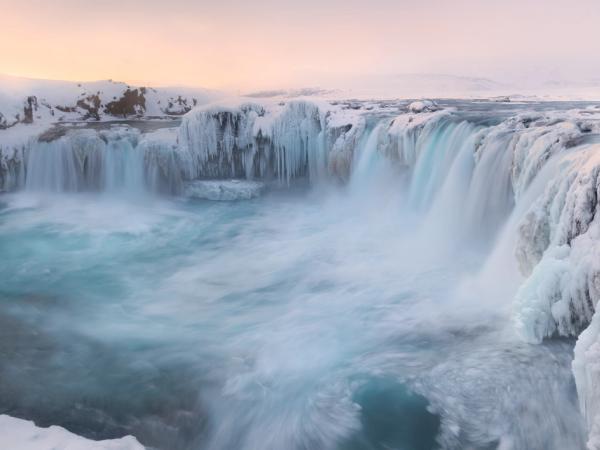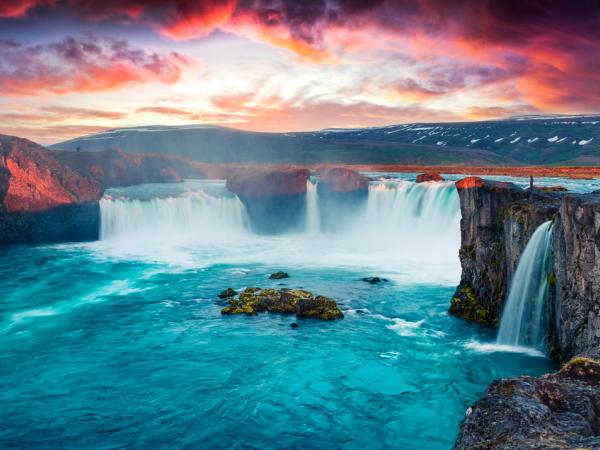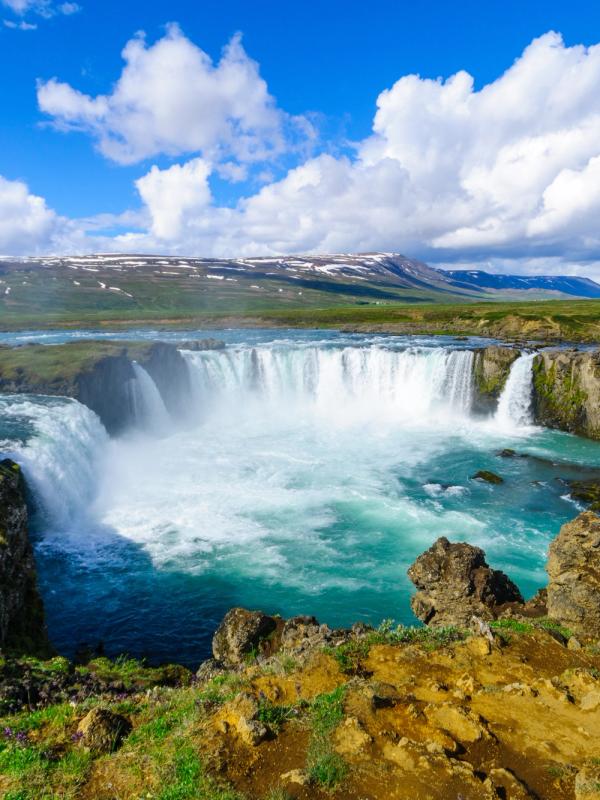
Guide to Goðafoss: All about the Waterfall of the Gods
There are hundreds of waterfalls in Iceland. They come in all shapes and sizes. You can find tall and powerful ones, thundering over impressive cliffs. Some are tall and thin, probably some of the tallest you’ve ever seen. Others are not as large, but they are surprising in many other ways. Unique shapes, amazing surroundings, and even different colors.
Of this last kind, Goðafoss is, without a doubt, one of the most beautiful and enchanting waterfalls in the entire country. It’s not huge, but its looks usually leave visitors speechless. This iconic waterfall, situated in Northern Iceland along the scenic Diamond Circle, is also steeped in history and mysticism, making it one of the top destinations in this part of the island.
In this guide, we’ll walk you through all there is to know about this gem and where you can go with your campervan nearby to spend the night. Let’s dive in!
Key Takeaways
- Goðafoss is one of the most beautiful and visited waterfalls in Iceland.
- It’s one of the five main stops of the Diamond Circle.
- What usually strikes visitors the most is the color of the water.
Why is Goðafoss Worth a Visit?
Goðafoss is a captivating place for several reasons. This waterfall attracts visitors from all over the world for its natural beauty and historical significance. Its name means “Waterfall of the Gods” in Icelandic. By looking at it, one could think that its name comes from the mystical appearance it has. The waterfall itself is a stunning crescent, where white water plunges over dark volcanic rocks into the turquoise waters of the Skjálfandafljót River. It’s a breathtaking sight that seems out of a fairytale, surrounded by basalt formations. As soon as you get there, you’ll be struck by the color of the water.
However, the reason for its name comes from a pivotal moment in Iceland’s history. Around the year 1000, according to the legend, lawspeaker and local chieftain Þorgeir Ljósvetningagoði took the decision to convert the nation’s religion to Christianity. To symbolize this change, he threw his pagan idols to the falls, as a token of the rejection of the nation of their former beliefs. This fact adds a historic layer to this already amazing natural monument.
Another reason to go to Goðafoss is its accessibility. The waterfall is just off the Ring Road (Route 1), so it’s very easy to stop there as part of your campervan itinerary. It has easy parking and, from there, short paths leading to different viewing points. It can be accessed on both sides of the river. The east side, closer to the parking area, offers a panoramic view of the falls. The west side provides a closer view and a trail that leads down to the riverbank.
Beyond its beauty, Goðafoss is a gateway to the Diamond Circle, a scenic route that goes through North Iceland’s best geological wonders and cultural treasures.

Goðafoss Facts and Features
The two main reasons Goðafoss is known for are its shape and the color of its water. The waterfall measures approximately 12 meters (39 feet) in height and spans 30 meters (98 feet) in width, forming a graceful, horseshoe-shaped cascade. Then, the water is of a surprising turquoise hue, creating a contrast of colors that is not common to see.
Goðafoss is part of the Skjálfandafljót River, one of Iceland’s longest rivers. It originates on the northern part of Vatnajökull, the largest glacier in Iceland and Europe. Its flow varies with the seasons. It reaches its highest level by late spring, when the snow melts and feeds the river. In winter, the waterfall partially freezes, creating a beautiful postcard.
The surrounding landscape, shaped by ancient volcanic activity, features basalt columns and lava fields, formed around 7,000 years ago.
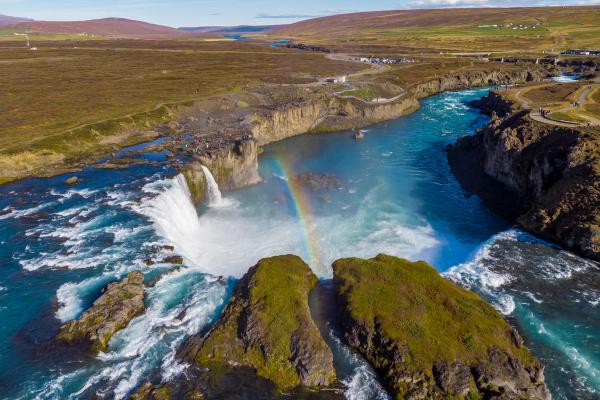
Where’s Goðafoss and How to Get There
As we have already mentioned, Goðafoss is located in North Iceland, not far from Akureyri, the second largest city in the country. The best way to get there is by car or campervan. This way you can tailor your route to your interests, going at your own pace. Public transport is quite limited.
The trip from Reykjavik is quite long, but very easy to follow. Goðafoss is approximately 420 kilometers (261 miles) from the capital, and it takes 5.5 hours to get there without stopping. But if you have your own vehicle, you can take breaks or detours to see other things. Start by taking the famous Ring Road (Route 1) northbound, passing through towns like Borgarnes and Blönduós.
After about 390 kilometers (242 miles), you’ll reach Akureyri, the most important city in North Iceland. From there, it’s just 30 kilometers (18.6 miles) until you see signs for Goðafoss. The roads are paved and well-maintained, with two parking areas on both sides of the waterfall (east and west). The east side has a café and more facilities, while the west side offers quieter views.
It's quite easy to get there, but check the road conditions, especially if you’re coming in winter, late autumn, or early spring, as the weather can lead to some road closures.
What to See and Do Near Goðafoss
North Iceland is a region that has some of the best natural monuments in the country. It’s, perhaps, not as well-known and visited as other regions because it’s far away from Reykjavik and traveling all the way up here takes some time. But once you're here, you’re in for a treat. Goðafoss is one of the five main stops of the Diamond Circle, a 250-kilometer (155-mile) scenic route that connects the best things to see in this part of the country. Similar to the Golden Circle in the south.
Lake Mývatn
One of the most astonishing monuments in this region is Lake Mývatn, a geologically active area known for its volcanic craters, bubbling mud pools, and rich birdlife. The water of the lake has an intense color as a result of the numerous mineral deposits. There are many pseudo-craters, formed by steam explosions when lava met water. It’s also one of the best birdwatching spots in Iceland, with several species living or migrating to the wetlands around the lake. The stars here are the harlequin duck, the tufted duck, and the common snipe.
You can also enjoy a relaxing geothermal soak in the Mývatn Nature Baths, one of the best natural spas in Iceland. Another great activity is to take a hike in Dimmuborgir, a labyrinth of lava formations that look like castles.
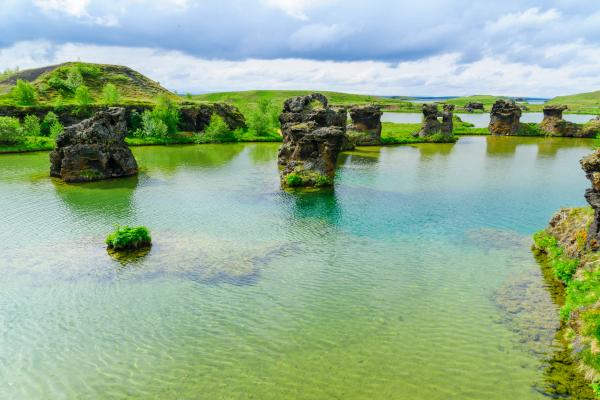
Ásbyrgi Canyon
Ásbyrgi is a horseshoe-shaped canyon formed thousands of years ago during a devastating glacial flood. Its tall, vertical walls reach up to 100 meters (328 feet) at some points, and there’s a beautiful birch forest with a pond at the bottom. Ásbyrgi is a hiker’s paradise, with several trails that go both to the upper and the lower areas. The visitor center provides maps and insights into the area’s geology.
This place has its bit of Norse mythology. The legend says that the canyon was formed when Sleipnir, Odin’s eight-legged horse, struck the Earth here with its hoof.
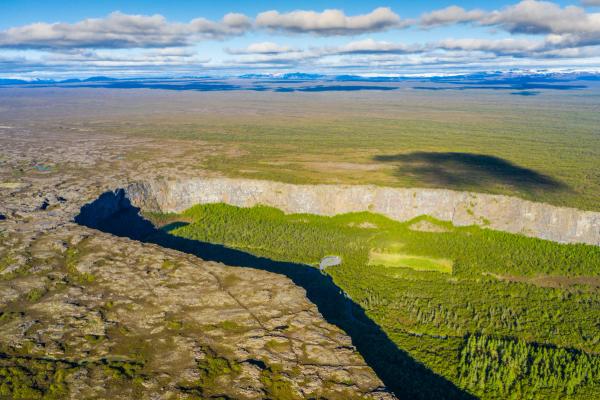
Dettifoss
Apart from Goðafoss, there’s another waterfall in the Diamond Circle. A little but further east on this route, Dettifoss is Europe’s second most powerful waterfall, creating a roar that can be heard from some distance. It’s 44 meters (144 feet) tall and 100 meters (328 feet) wide. There are viewing platforms on both sides of the waterfall, each one offering different perspectives. There are two other waterfalls nearby: Selfoss and Hafragilsfoss. One is upstream and the other down the river, but both are within walking distance.
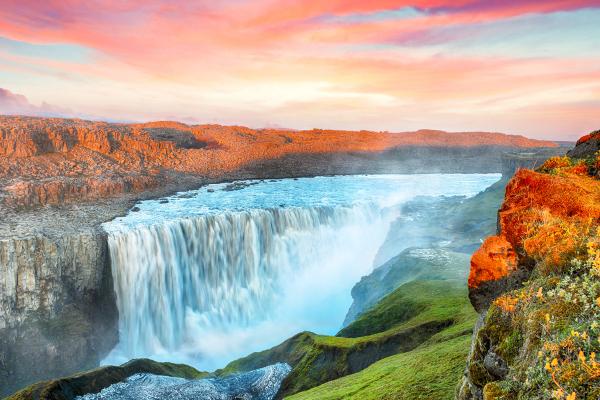
Húsavík
Many of the people who travel to Iceland have the hope to see whales, as the country is a fantastic destination in this sense. And there’s no better place for it than Húsavík, also known as the whale-watching capital of Iceland. Many companies offer boat tours that depart from the town’s harbor and get into Skjálfandi Bay, where the chances of sightings are very high. You can learn more about these huge mammals in the Húsavík Whale Museum, with comprehensive exhibitions about these animals and their habitats.
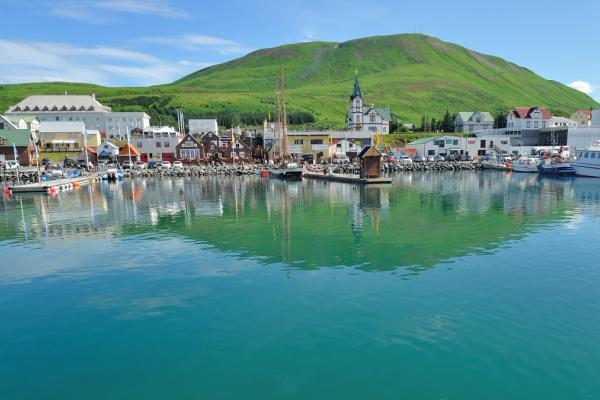
Akureyri
Approximately 25 kilometers (15.5 miles) west of Goðafoss, Akureyri is the second-largest city in Iceland. It has a vibrant cultural scene, with a busy downtown full of art galleries and restaurants. One of the most interesting attractions in town are the Akureyri Botanical Gardens, with a large collection of plants that survive in polar and cold climates.
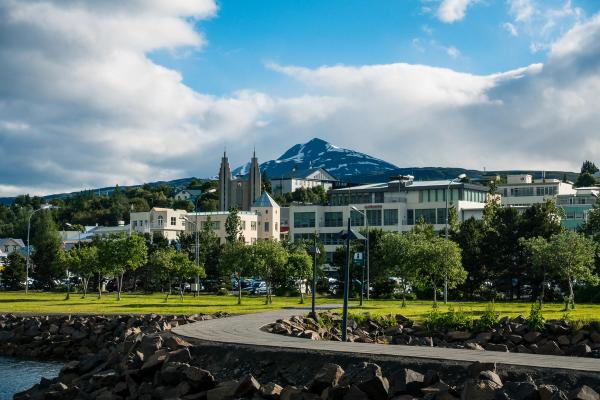
Forest Lagoon
This geothermal spa is just outside Akureyri, and it’s one of the latest additions to the bathing scene in Iceland. Opened in 2022, the Forest Lagoon is nestled in the middle of a birch forest, with views of the Eyjafjörður fjord. It features two main pools, at different temperatures, both filled with geothermal waters that come from the nearby Vaðlaheiði mountain, a Finnish-style sauna, and a cold pool.
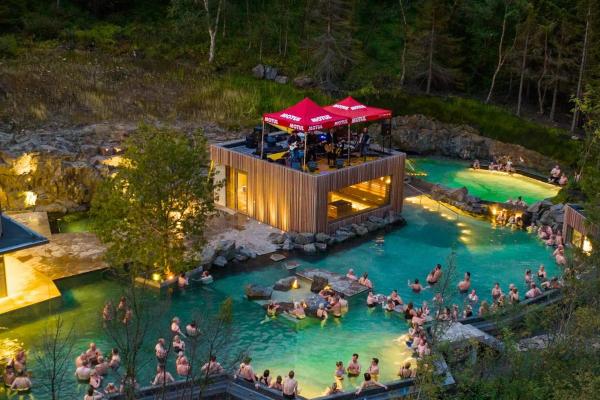
Where to Stay Near Goðafoss
The camping culture is strong in Iceland, and there are several places near Goðafoss where you can spend the night with your campervan. Please note that free camping is illegal in the country and can result in high fines, as well as being detrimental to the environment. Here you have five great options in the area:
Fossholl Guesthouse and Camping
Distance to Goðafoss: Literally there! Opening Period: Year-round.
Just a stone’s throw from Goðafoss, Fossholl Guesthouse and Camping is as close as you can get to the waterfall. It has basic facilities, including toilets, showers, and running water. The adjacent guesthouse has a café and shop, and is a good option if you want a more comfortable stay. Is recommended to book well in advance, as its unique location can make it fill up fast.
Laugar Camping
Distance to Goðafoss: 13 km (8 miles).Opening Period: May to September.
Located in the small village of Laugar, this campsite is a short drive from Goðafoss and ideal for exploring the Diamond Circle. It features modern facilities like toilets, showers, a communal kitchen, Wi-Fi, and electricity for campervans. There’s even a golf course next door.
CJA Camping
Distance to Goðafoss: 15 km (9.3 miles). Opening Period: All year.
This camping ground is located in the forest farm Hjalli, in the valley Reykjadalur. It’s a family-friendly site with toilets, showers, electricity, washing machine and dryer, and cooking facilities. The owners also run a small guesthouse.
Vaglaskógur Camping Site
Distance to Goðafoss: 26 km (16 miles). Opening Period: May to September.
Set in a beautiful forest in Fnjóskárdalur valley, Vaglaskógur is one of the most complete camping grounds in North Iceland. It features toilets, showers, electricity, a washing machine and dryer, a children's playground, and sheltered pitches for windy days. The facilities are also accessible to individuals using wheelchairs.
Systragil Camping Ground
Distance to Goðafoss: 25 km (15.5 miles). Opening Period: June to September.
Located in the same valley as Vaglaskógur, about 20 minutes from both Goðafoss and Akureyri. It has spacious pitches for tents and campervans sheltered by trees, toilets, showers, electricity, a washing machine and dryer, and cooking facilities.
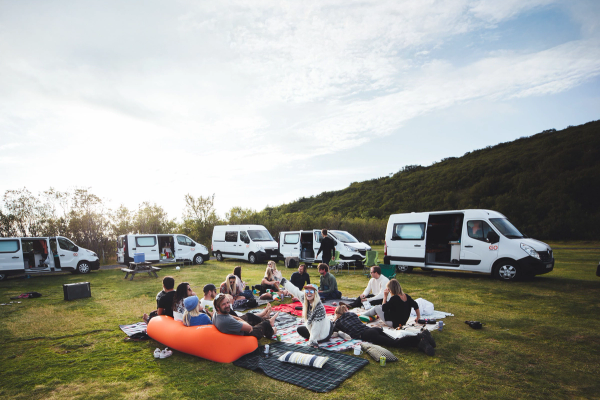
The Seasons at Goðafoss
Your visit to Goðafoss can be very different depending on when you go.
Spring (April and May)
The fields around Goðafoss start to wake up after the long winter. This season features cool temperatures, ranging from 5 to 10°C (41 to 50°F). The snowmelt makes the waterfall look especially dramatic. There could still be some snow lingering, and the trails can be muddy.
Summer (June to August)
Summer is the peak season, with long daylight hours, almost 24 hours a day by the end of June, providing plenty of time to explore Goðafoss and its surroundings. The weather is mild, ideal for camping and hiking, but popular sites like Goðafoss can get busy. The average temperatures hover around 10 to 15°C (50 to 59°F). The region can be crowded with tourists, and camping sites can become busy, so it's best to book in advance whenever possible.
Autumn (September and October)
This season is similar to Spring, but moving in the opposite direction. The temperature averages between 1 and 10°C (34 and 50°C), and the fields and forests near Goðafoss change their colors. The waterfall’s flow remains strong, and Northern Lights sightings are possible on clear nights. Some campsites close in September, so check availability. On the other hand, there are not many tourists.
Winter (November to March)
Winters are long and cold in North Iceland, but they also come with their advantages. Goðafoss transforms into a beautiful postcard, with ice framing the falls. The temperature often drops below freezing point, and the days are quite short, so you’ll need to plan your day to maximize natural light. Most campsites are closed, but some remain open. The roads can close if the weather is too bad, so check their status regularly to avoid unpleasant surprises. You’ll need to rent a 4x4 campervan to deal with the icy roads.
What to Pack to Visit Goðafoss
Iceland’s peculiar weather makes it necessary to pack carefully. Regardless of the season, there are a few items that should be in your bag.
- Warm Sleeping Bag: Choose one rated for -5 to 5°C (23–41°F) for campervan camping, as nights can be chilly even in summer.
- Waterproof and Windproof Clothing: In Iceland, the weather changes a lot, and rain can strike at any moment. Also, you can get wet close to the waterfall.
- Layered Clothing: The best way to deal with the temperature changes is to dress in layers. A thermal inner layer, a moisture-wicking one for intermediate, and the aforementioned waterproof jacket on the outside.
- Portable Gas Stove and Cooking Gear: Not all campsites have kitchen facilities, so bring a stove, cutlery, and a pan for warm meals. Many campervan rentals include them.
- Power Bank: Keep devices charged, as some campsites may lack reliable electricity.
- Quick-Dry Towel: Useful for showers at campsites or for a bath in a geothermal area.
- Maps and GPS: Download offline maps or use a GPS device, as cell service can be spotty in rural areas.
- Sunscreen and Sunglasses: Protect against UV rays, especially during summer’s long daylight hours. In winter, they protect against the glare off the snow.
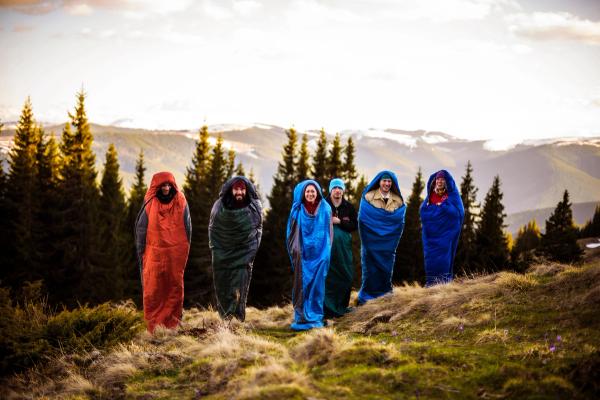
Travel Tips
- Check Weather and Road Conditions: The Icelandic Met Office provides the most accurate forecasts, while the Icelandic Road and Coastal Administration has updated info on road conditions.
- Book Campsites Early: The camping grounds can get very busy in summer, so reserve a spot via the Parka app or contact campsites directly.
- Respect Nature: Stick to marked paths to protect Iceland’s fragile ecosystem, and avoid wild camping, which is illegal in the entire country.
- Plan for Short Days in Winter: Daylight is limited to 4–5 hours, so make a list of your priorities in case you run out of time.
- Bring Cash or Card: Most campsites accept cards, but small fees (e.g., showers) may require cash in ISK.
- Stock Up: Grocery stores are scarce outside Akureyri, so buy food and fill up your tank in larger towns.
- Drive Carefully: Gravel roads and strong winds are common, so maintain a steady speed and check your campervan’s insurance for gravel damage.
Conclusion
There are not many places in Iceland as striking and beautiful as Goðafoss. Its natural, raw beauty is something to behold, linked to a rich history as well. It’s the perfect blend of adventure and tranquility. And, on top of that, it is located in one of the most amazing regions in Iceland, perfect for creating an itinerary and being surprised by all there’s to see here. Rent your campervan, hit the road, and get ready for a once-in-a-lifetime experience.


